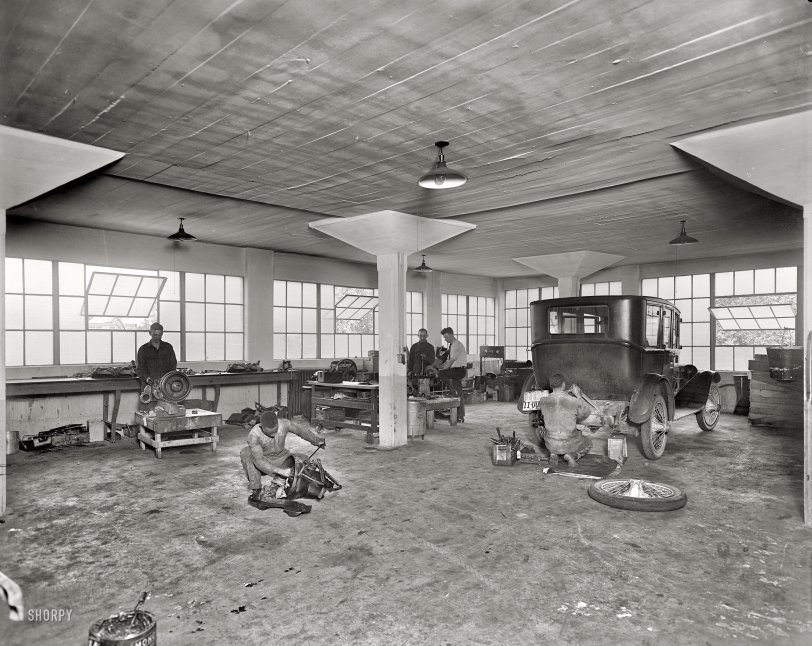


Framed or unframed, desk size to sofa size, printed by us in Arizona and Alabama since 2007. Explore now.
Shorpy is funded by you. Patreon contributors get an ad-free experience.
Learn more.

- Freeze Frame
- Texas Flyer wanted
- Just a Year Too Soon
- WWII -- Replacing men with women at the railroad crossing.
- Yes, Icing
- You kids drive me nuts!
- NOT An Easy Job
- I wonder
- Just add window boxes
- Icing Platform?
- Indiana Harbor Belt abides
- Freezing haze
- Corrections (for those who care)
- C&NW at Nelson
- Fallen Flags
- A dangerous job made worse
- Water Stop
- Passenger trains have right of way over freights?
- Coal
- Never ceases to amaze me.
- Still chuggin' (in model form)
- Great shot
- Westerly Breeze
- For the men, a trapeze
- Tickled
- Sense of loneliness ...
- 2 cents
- Charm City
- What an Outrage
- Brighton Park
Print Emporium
Oakland Garage: 1921

Washington, D.C., 1921. "District Oakland Automobile Co. garage, L Street." The Oakland was eventually eclipsed by Pontiac, its "companion make" in the General Motors hierarchy. Harris & Ewing glass negative. View full size.
Perspective of time
If you will notice the space needed for the starter motor on the transmission in the back you can guess the rough size of the electric starter need for one of these cars. It most likely weighed in close to 80 pounds. And was enormous! Still beats turning a crank to start a car (Which I have done on a 1912 Mack).
The transmission at the from is most likely from a Model T since it is pedal operated, one was for reverse and one was for forward, you accelerated giving it gas while advancing the timing via a lever on the steering wheel!
And with gravity feed to the carburetor you had to back up the really steep hills so you would not run out of fuel. You almost needed the coordination of a helicopter pilot to drive back then. Controls on cars back the were vastly different from make to make, the only common parts being the accelerator, steering wheel and the brake. The average driver of today would be lost in an early T and vice versa. Though the latter would have an easier time than the former in learning to operate a modern vehicle.
[The transmission would not have been from a Model T; Oakland was a General Motors brand. And incidentally, Model T's didn't have accelerator pedals. The throttle was a lever on the steering column. - Dave]
Primitive compared to today's technology
The fellow forced to work on the floor appears to be cleaning the bellhousing of the transmission. The clutch release bearing slides on a shaft and the shaft has to be clean and lubricated for smooth operation of the clutch pedal. The fellow standing to his rear is keeping the flywheel housing from rolling away. Note the teeth around the circumference of the flywheel. These are engaged by the starter motor, which attaches to the opening slightly lower and to the rear of the housing. As a professional ASE CMAT L1 (mechanic) I enjoy seeing these shops from the infancy of the automobile. The homemade tester in the right rear corner of the shop intrigues me as to its purpose. The fellow with bended knee is obviously an engineer since a mechanic would not wear a necktie working around rotating machinery, or wear a white shirt, or polished shoes. See the mechanic looking into the camera, working on the engine block..he knows safety! The fellow with his back to the camera is a bodyman. Look at the box of hammers and screwdrivers, ready to tackle almost any impact imaginable.
Call me silly
But why does that car have two tags? Laziness (never bothered to take the old one off) or were they required?
[One is for Maryland and the other for D.C.]
Rooftop parking
Judging from the material in the ceiling, and size and shape of the supporting columns, I'd guess that this building has rooftop parking.
[The service garage was on one of the upper levels of this four-story building, which had a big OAKLAND sign on the roof. - Dave]
























On Shorpy:
Today’s Top 5